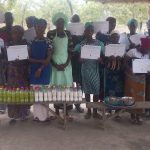 Meeting Needs — and there are immense needs in the two-thirds world. One-half of those who die in the villages of developing countries are under five years of age! Most of these deaths are due to a combination of malnutrition and infection. Diarrhea and gastrointestinal diseases abound, due to contaminated water and food, improper waste disposal, and poor hygiene, sanitation, and nutrition. UNICEF reports 40,000 children die each day of diseases that are preventable.
Meeting Needs — and there are immense needs in the two-thirds world. One-half of those who die in the villages of developing countries are under five years of age! Most of these deaths are due to a combination of malnutrition and infection. Diarrhea and gastrointestinal diseases abound, due to contaminated water and food, improper waste disposal, and poor hygiene, sanitation, and nutrition. UNICEF reports 40,000 children die each day of diseases that are preventable.
Serious respiratory diseases occur frequently because of overcrowded living situations, low resistance due to poor nutrition, and lack of knowledge of how to prevent transmission to other family members. Typhoid, diphtheria, tetanus, and whooping cough are common diseases that can be prevented through the use of inoculations (vaccinations). Environmental health diseases transmitted by snails, insects, and other animals can be prevented by the use of other modern medicines.
Good health is more than just medical elements. For a person to be truly healthy many elements are involved. To this end CHE attempts to deal with the elements presented below:
*** Spiritual Care
*** Emotional Self-Worth
*** Good Health
****** Health
****** Education
****** Agriculture
****** Literacy
****** Sanitation
****** Nutrition
****** Immunization
CHE is a multifaceted, community-based, development strategy that deals with the whole man – physically, spiritually, emotionally, and socially. CHE training teams equip local villagers as CHEs in the needed physical, social or emotional topics, and spiritual area. The CHEs then put into practice what they have learned in their own lives and share this with 10 – 15 neighboring families.
Historically, most of the available medical personnel and funds in the developing world have been committed to hospitals, which provide curative care for only five to ten percent of the population. In most of the two-thirds world countries, 80 percent of the health professionals are found in cities, while 80 percent of the people live in rural areas. The majority of the clinics and hospitals are also in the cities.
The best medical care is to prevent the disease before it occurs. Curative medicine seeks recovery from existing diseases rather than preventing diseases. It is expensive and not available to the majority of the people, especially those in rural areas and villages. Therefore, CHE places its greatest emphasis on prevention, which involves community development. However, there is still a need for resources of curative care, such as clinics and local hospitals for dealing with the more serious illnesses.
Although most diseases are preventable through health education and immunizations, we also train CHEs to recognize basic diseases and treat them in the home. As an example, in Africa worms can be treated with pawpaw milk. In addition, CHEs are taught how to recognize the signs and conditions severe enough to need treatment at the hospital.
CHEs also meet needs in another critical area – malnutrition. CHEs teach how to grow and properly prepare vegetables and other foods. The “Food 3×3” lesson plan is an easy way to remember what foods to eat at every meal: (1) an energy food – potatoes or bread; (2) a body-building food – beef or fish; and (3) a protective food – oranges or pineapples.
Sanitation can be a problem in houses made of mud and when access to water is limited. A crucial factor for health is to train people to build pit latrines and keep clean homes. Many villages have no running water, so people walk three to four kilometers to draw water from a dirty river. CHEs teach villagers how to find a clean source of water and how to protect it to keep it clean. They also teach ways to purify water. In addition to teaching the villagers about sanitation, the CHEs tell them how Jesus Christ can cleanse their lives of sin permanently.











Recent Comments